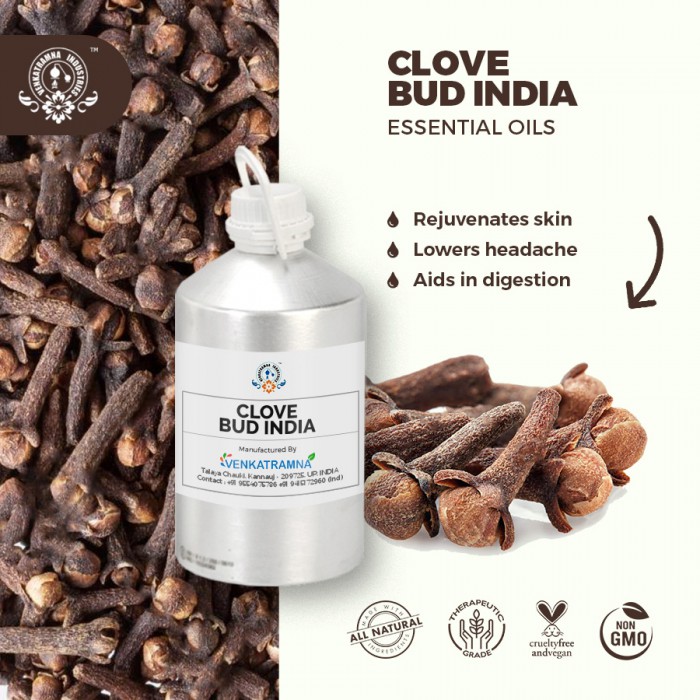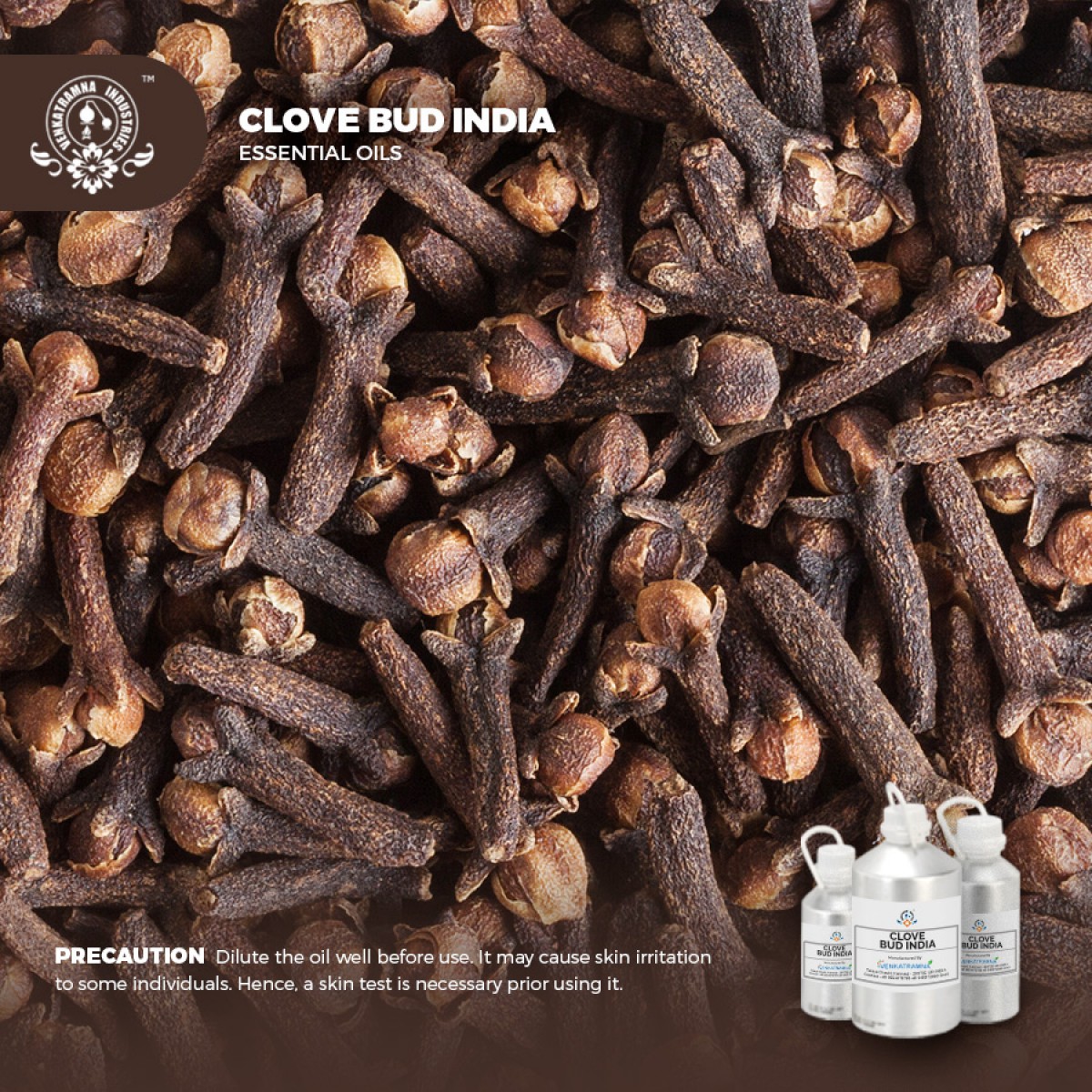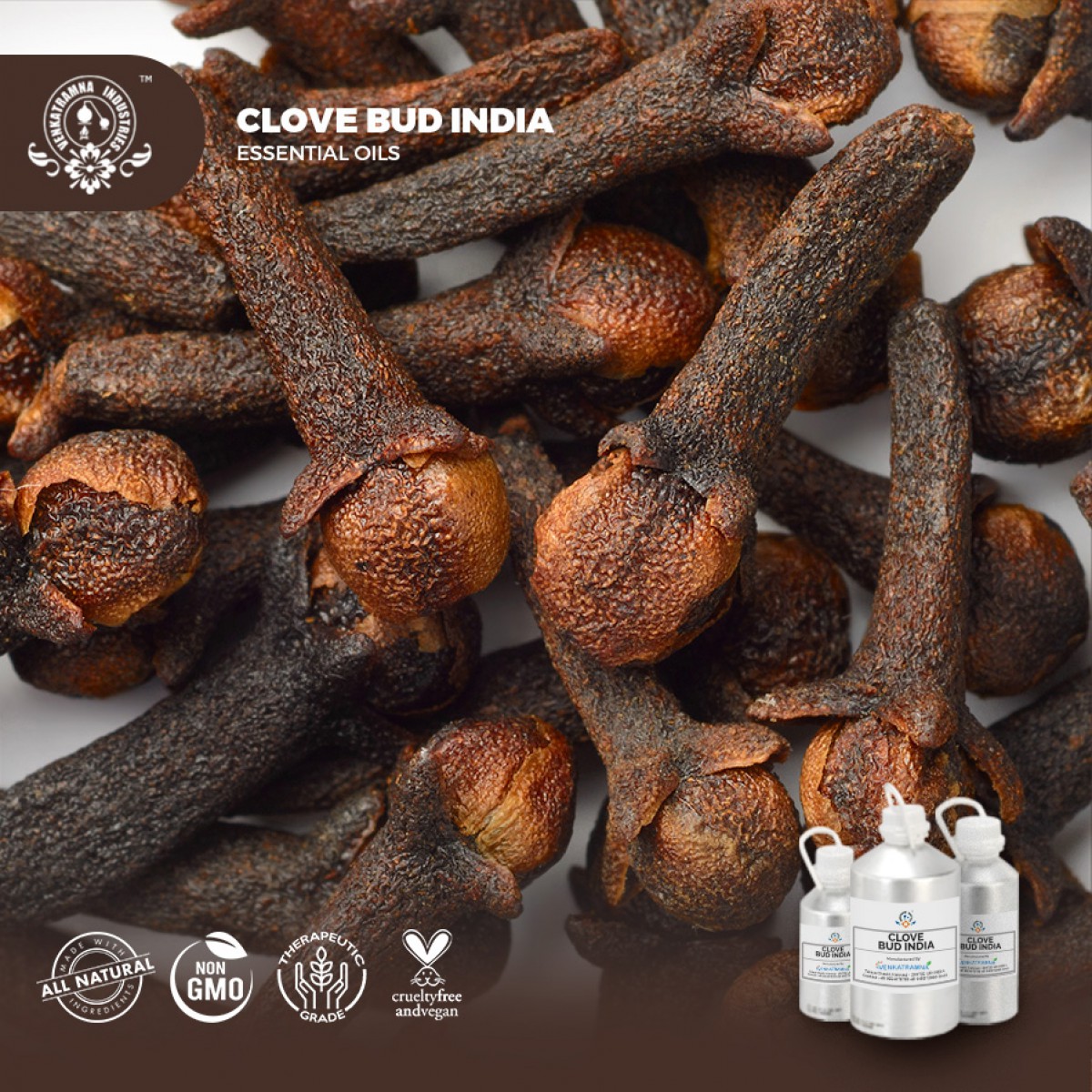Botanical Name : Syzgium aromaticum L. Common name: Kanafuru, Pla Read More
|
Botanical Name : |
Syzgium aromaticum L. |
|
Common
name: |
Kanafuru, |
|
Plant family: |
Myrtaceae |
|
Genus: |
Syzgium |
|
Appearance/Color: |
A clear pale yellow to yellow liquid of medium
consistency. |
|
Odor: |
A middle note of medium aroma, Clove Bud Essential Oil smells
like the actual spice. |
|
Blends With: |
Blends well with other spice oils including Cinnamon Bar,
Nutmeg, Citronella, Grapefruit, Lemon, Orange, Peppermint, Rosemary and Rose. |
|
Origin: |
India |
|
Source: |
Dried Flower Buds |
|
Method of
Extraction |
Steam Distillation |
One of the earliest known spices
in trade, the dried, aromatic flower buds produced by this medium-sized tree
are familiar to many of us as a common kitchen spice.
Clove contains several volatile
oils, the most significant of which is eugenol that comprises up to 90% of the
total oil produced. Eugenol has numerous medical and commercial applications
and continues to be extracted primarily from clove buds, though it can also be
extracted from the leaves of the clove tree and from some other plants, such as
allspice (Pimenta dioica), in smaller quantities.
Clove was originally found only
on the Maluku Islands of Indonesia, but in the 17th century fierce competition
between warring European nations that sought control of the spice trade
eventually led to clove trees being transported all over the world for
cultivation.
The historical importance of clove in international trade means it is now grown in numerous locations throughout the tropics including Indonesia, Zanzibar, Madagascar, Sri Lanka and parts of the Caribbean. More recently, clove production has begun in the Brazilian state of Bahia. Clove grows best on tropical mountain slopes at lower elevations as part of a mixed forest. Many of the islands to which they are native are volcanic.
DISCLAIMER
The complete range of conditions
or methods of use are beyond our control therefore we do not assume any
responsibility and expressly disclaim any liability for any use of this
product. Information contained herein is believed to be true and accurate however,
all statements or suggestions are made without warranty, expressed or implied,
regarding accuracy of the information, the hazards connected with the use of
the material or the results to be obtained from the use thereof. Compliance
with all applicable federal, state, and local laws and local regulations
remains the responsibility of the user.
The FDA has not evaluated the
statements on this website. No claims are made by Venkatramna Industries as to
the medicinal value of any products from vriaroma.com or by us. The information
presented here is for educating our customers about the traditional uses of
essential oils and is not intended to diagnose, treat, cure, or prevent any
disease. You are responsible for understanding the safe application of these products.
If you have any questions, please call or email us for further information.
As per NAHA guidelines, New Directions Aromatics (NDA) does not recommend the ingestion of essential oils. It is imperative to consult a medical practitioner before using Essential Oils for therapeutic purposes. Pregnant and nursing women and those taking prescription drugs are especially advised not to use this product without the medical advice of a physician. The oil should always be stored in an area that is inaccessible to children, especially those under the age of 7.
Clove is most famous for its use
as a spice and has been valued for centuries for the unique flavor and
preservative qualities it can impart to food. In Europe, whole cloves are commonly
pressed into red meats before cooking and are also included in many seasonal
dishes, such as mulled wine at Christmas. Clove is an important ingredient in
many spice mixes, including most garam masala and Chinese five-spice mixes.
Clove Essential Oil in Pharma
Although best known in Asian
medical systems such as Ayurveda, clove has numerous applications in
traditional and modern medicine with a broad range of different therapeutic
effects having been reported. Its confirmed antimicrobial, antifungal,
antiviral and anti-inflammatory properties have made it popular for treating a
variety of different infections, for example as a gargle for sore throats or
for cleaning minor wounds. It is also commonly used for digestive
complaints because of its antispasmodic action, and some studies report that
clove can reduce the likelihood of gastric ulcer formation. Modern
research interest into the uses and efficacy of clove is high, with numerous
studies investigating it for anti-carcinogenic, chemoprotective and other properties.
Some studies have also shown that clove can work synergistically with other
medicinal plants to fight bacterial infection more effectively.
Essence of Clove Essential Oil
Clove oil is an ingredient in
several popular perfumes and the source of raw materials used for manufacturing
fragrances and flavorings. Oils are often extracted from the leaves of the tree
as well as the flower buds for fragrance manufacturing purposes. Clove was also
formerly used to synthesize vanillin - artificial vanilla flavoring. It is an
main ingredient of Indian spices.
Clove is well known as a
traditional home remedy for mild toothache and inflammation of the mouth
because of its analgesic and antiseptic effects. It has also been traditionally
used to treat bad breath and tooth decay and has a long history of use in
dentistry. Eugenol, the primary constituent extracted from clove, is still used
in several dental products and processes today.
COMMON USAGE
·
Prevents dental problems
·
Rejuvenates skin
·
Improves immunity
·
Reduces anxiety and stress
·
Cures respiratory ailments
·
Lowers headache
·
Eliminates earaches
·
Aids in digestion
·
Cures nausea
·
Stimulates blood circulation
·
Acts as blood purifier
·
Prevents premature ejaculation
·
Controls sugar level
·
Cures cholera
·
Works as cancer preventive agent
Ingredients:
|
S.No |
Key Constituents |
Strength (%) |
|
1 |
Eugenyl acetate |
0.6-01.7 |
|
2 |
Eugenol |
63.5-56.7 |
|
3 |
b-caryophyllene |
01.04-0.2 |
|
4 |
Isoeugenol |
01.04-0.2 |
|
5 |
a-caryophyllene |
0.05-1.12 |
|
6 |
Methyl-eugenol |
0-0.2 |
TOXICOLOGICAL
INFORMATION
Safety Summary
·
Hazardous: Drug interaction; may contain
methyl-eugenol; may inhibit blood clotting; embryotoxicity; skin sensitization
(moderate risk); mucous membrane irritation (moderate risk). Cautions (oral):
May interact with pethidine, MAOIs or SSRIs. Anticoagulant medication, major
surgery, peptic ulcer, hemophilia, other bleeding disorders.
·
Contraindications: Hypersensitive, diseased or
damaged skin, children under 2 years of age. Maximum dermal use level.
Maximum dermal
use level (based on methyl-eugenol content)
|
EU |
0.1% |
|
IFRA |
0.2% |
|
Tisserand and young |
10% |
Maximum dermal
use level (based on eugenol content)
|
EU
NO |
Legal
limit |
|
IFRA |
0.4% |
|
Tisserand and young |
0.4% |
Organ Specific Effects
·
Adverse Skin Reactions: skin sensitizing
potency, clove leaf oil was a weak sensitizer, with a similar potency to
eugenol.
·
Cardiovascular effects: Eugenol is a
powerful inhibitor of platelet aggregation, an essential step in the blood
clotting cascade.
Systemic Effects
·
Acute Toxicity
o Oral
route: DL50 = 2650 mg/kg
o
Dermal route: DL50 > 5000 mg/kg
·
Respiratory sensitization: Not applicable under
normal use.
·
Germ cell mutagenicity: Cause for concern owing
to the possibility that it may induce heritable mutations in the germ cells of
humans.
·
Carcinogenicity: IARH: No component of this
product present at levels greater than or equal to 0.1% is identified as
probable, possible or confirmed human carcinogen by IARC. ACGIH: No component
of this product present at levels greater than or equal to 0.1% is identified
as probable, possible or confirmed human carcinogen by IARC.
·
NTP: No component of this product present at
levels greater than or equal to 0.1% is identified as probable, possible or
confirmed human carcinogen by IARC.
·
OSHA: No component of this product present at
levels greater than or equal to 0.1% is identified as probable, possible or
confirmed human carcinogen by IARC.
·
Reproductive toxicity: Not specified
·
STOT-single exposure: Not specified
·
STOT-related exposure: Not specified
·
Aspiration hazard: Not specified
ECOLOGICAL
INFORMATION
·
Toxicity
Harmful to aquatic life with long lasting effects. The product must not be
allowed to run into drains or waterways.
·
Substances classified as category 1 Acute
toxicity
·
Persistence and degradability: Biodegradation is
expected
·
Bio-accumulative potential Bioaccumulation is
unlikely
· Mobility in soil Unknown





 MSDS-Clove.pdf
MSDS-Clove.pdf




